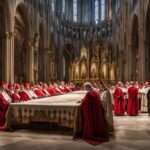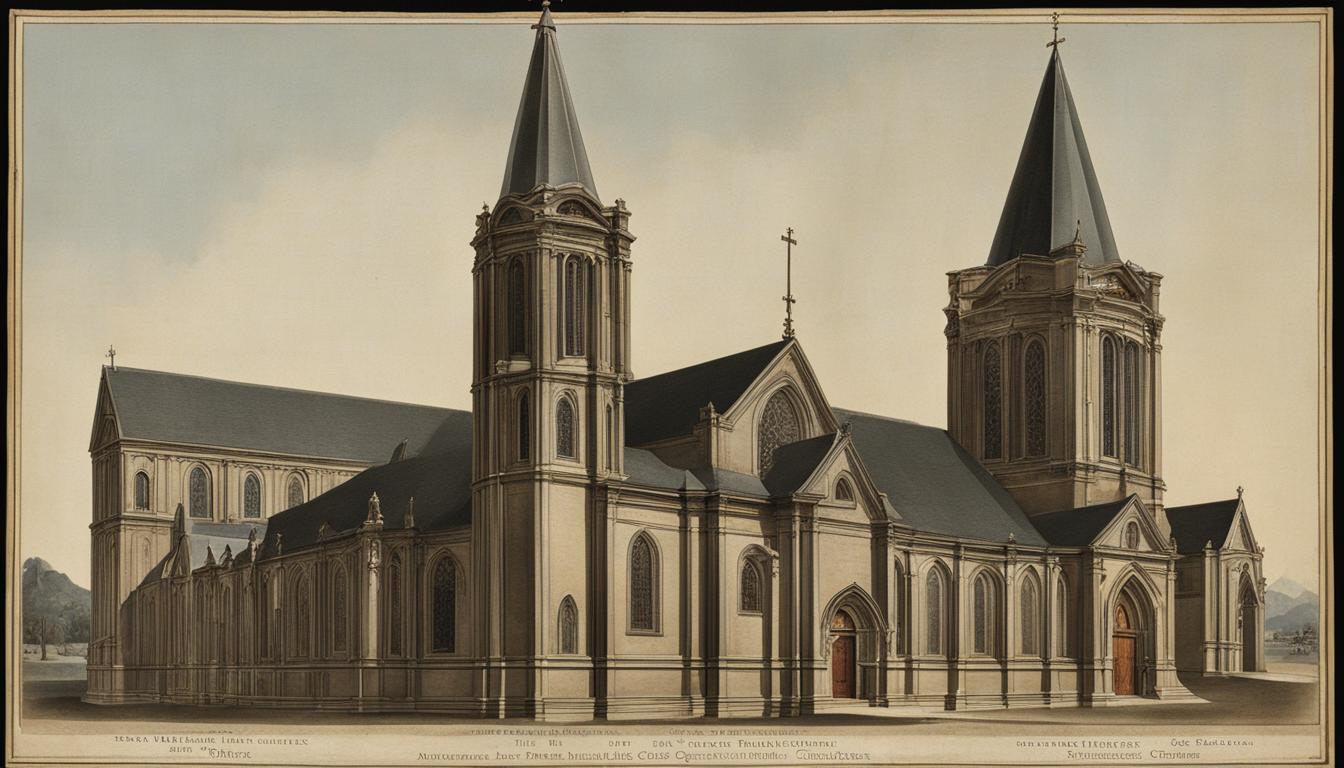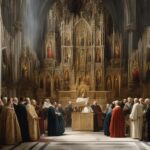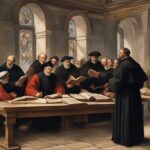The Second Vatican Council, commonly referred to as Vatican II, marked a significant turning point in the history of the Catholic Church. This transformative event brought about a series of reforms that have had a lasting impact on the Church’s theology and practices.
Key Takeaways:
- The Second Vatican Council, also known as Vatican II, introduced reforms that have shaped the Catholic Church.
- Changes in liturgical practices, teachings, and ecclesiastical structures are part of the developments since Vatican II.
- Vatican II emphasized the importance of active participation of the laity and dialogue with other Christian denominations and religions.
- Interpretation and implementation of Vatican II continue to be subjects of ongoing debate and discussion.
- The reforms initiated by Vatican II remain relevant to the Catholic Church’s engagement with the modern world.
The Impact of Vatican II on Liturgical Reforms
Vatican II had a profound impact on liturgical practices within the Catholic Church. The Council recognized the need for greater participation of the laity in worship and introduced significant changes to the way Mass was celebrated. One of the key documents that outlined these reforms was the Constitution on the Sacred Liturgy, also known as Sacrosanctum Concilium.
This document emphasized the important role of the liturgy in the spiritual life of the faithful and called for a greater emphasis on active participation. It encouraged the use of the vernacular language in the liturgy, allowing for a deeper understanding and engagement with the prayers and rituals. This shift from Latin to the vernacular language made the Mass more accessible and meaningful to the laity.
“The liturgy is the summit toward which the activity of the Church is directed; it is also the fount from which all her power flows.”
– Sacrosanctum Concilium
In addition to the use of the vernacular language, Vatican II also promoted greater involvement of the laity in the liturgy. The Council emphasized the importance of their active participation, encouraging them to take on roles such as lectors and extraordinary ministers of Holy Communion. This shift created a more inclusive and participatory worship experience.
In summary, Vatican II brought about significant liturgical reforms within the Catholic Church. The use of the vernacular language, increased involvement of the laity, and emphasis on active participation transformed the way Mass was celebrated. These reforms aimed to make the liturgy more accessible, meaningful, and engaging for the faithful.
Changes in Catholic Teachings and Doctrine
The Second Vatican Council, commonly known as Vatican II, had a profound impact on Catholic teachings and doctrine. The Council marked a significant shift in the Church’s approach to various aspects of faith and theology, reflecting the changing dynamics of the modern world. The reforms introduced during Vatican II continue to shape the Catholic Church’s identity and engagement with believers and non-believers alike.
One of the major changes brought about by Vatican II was the emphasis on the role of the laity in the Church. The Dogmatic Constitution on the Church, also known as Lumen Gentium, recognized the importance of lay participation and involvement in the life of the Church. It acknowledged that all members of the Church, not just the clergy, have a role to play in fulfilling God’s mission on earth.
Furthermore, Vatican II also fostered a more open and inclusive approach to ecumenism. The Dogmatic Constitution on Divine Revelation, known as Dei Verbum, highlighted the centrality of Sacred Scripture in the life of the Church and called for a deeper understanding and appreciation of the Bible. This led to a renewed emphasis on Scripture study and engagement with other Christian traditions, as well as dialogue with non-Christian religions.
| Vatican II Teachings | Impact on the Church |
|---|---|
| Recognition of the role of the laity | Inclusion and active participation of lay members in the life of the Church |
| Emphasis on ecumenism | Promotion of dialogue and cooperation with other Christian denominations |
| Affirmation of religious liberty | Recognition of the right to freedom of religion |
The changes introduced during Vatican II marked a shift in the Catholic Church’s approach to theology and its relationship with the modern world. The Council emphasized the importance of the laity, ecumenism, and religious freedom, aiming to create a more inclusive and engaged Church that could address the challenges and opportunities of the 20th century and beyond.
These changes have had a lasting impact on the Catholic Church and continue to shape its theological and pastoral practices. The teachings and documents of Vatican II provide a framework for understanding and interpreting Catholic faith in the contemporary context, while also calling for ongoing dialogue, reflection, and adaptation to meet the needs of a changing world. Vatican II remains a significant milestone in the history of the Church, prompting ongoing discussions and debates about its interpretation and application.
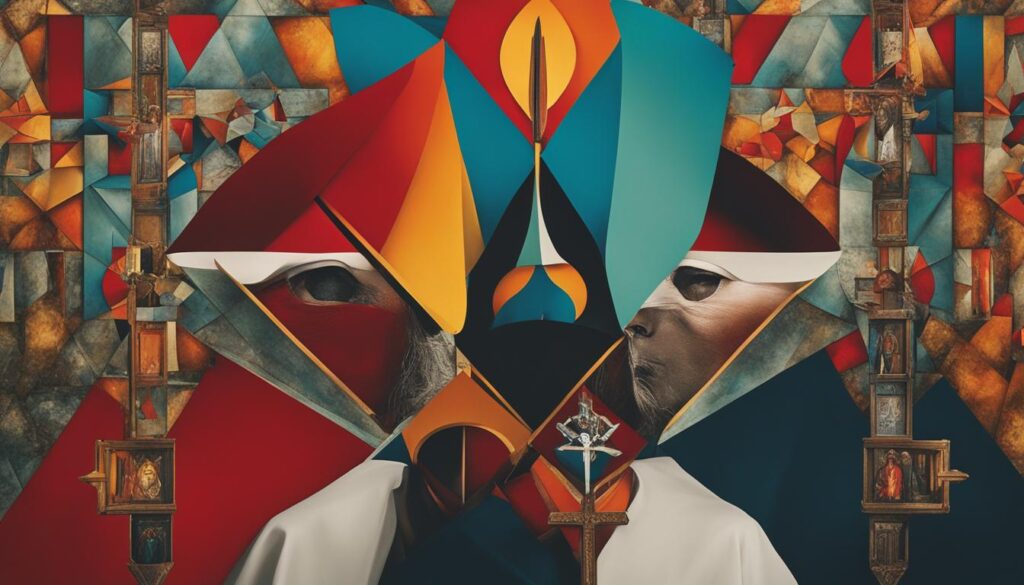
Ecclesiastical Changes Since Vatican II
The Second Vatican Council, or Vatican II, not only brought significant liturgical and theological reforms to the Catholic Church but also led to various ecclesiastical changes that have shaped the Church’s identity and relationships. These post-conciliar developments have played a crucial role in fostering dialogue, inclusivity, and cooperation within the Catholic Church.
One of the key ecclesiastical changes initiated by Vatican II was the Decree on Ecumenism. This document emphasized the importance of building relationships with other Christian denominations and promoting unity among all Christians. It called for dialogue, cooperation, and mutual understanding, encouraging Catholics to work towards reconciliation and common goals with their fellow Christians. This ecumenical focus has contributed to a more collaborative and harmonious approach to interdenominational relations.
Another important ecclesiastical change resulting from Vatican II is the Decree on the Eastern Catholic Churches. This document recognized the diversity within the Catholic Church, particularly the existence of Eastern Catholic communities with their unique liturgical and spiritual traditions. The decree affirmed the rights and autonomy of these Eastern Catholic Churches, encouraging mutual respect and collaboration between the Eastern and Western traditions within Catholicism.
| Ecclesiastical Changes Since Vatican II | |
|---|---|
| Decree on Ecumenism | Promotes dialogue, cooperation, and unity with other Christian denominations |
| Decree on the Eastern Catholic Churches | Acknowledges the diversity within the Catholic Church and affirms the rights of Eastern Catholic communities |
These ecclesiastical changes have not only strengthened the Catholic Church’s relationships with other Christian communities but also highlighted the inclusivity and diversity within the Church itself. The recognition of different traditions and the promotion of unity have fostered a spirit of collaboration and understanding, allowing for a richer and more vibrant Catholic Church in the post-Vatican II era.
The Evolution of Catholic Church Practices
Vatican II played a crucial role in modernizing Catholic Church practices. The Declaration on the Relationship of the Church to Non-Christian Religions promoted interreligious dialogue and understanding, fostering a more inclusive approach to other faiths. This emphasis on dialogue aligns with the Council’s vision of the Catholic Church as a bridge-builder and advocate for peace and reconciliation.
The Dogmatic Constitution on Divine Revelation emphasized the importance of Scripture in shaping Catholic beliefs. This recognition of the significance of the Bible led to increased emphasis on Scripture study, reflection, and interpretation. The Council encouraged Catholics to engage actively with the Word of God, both individually and within the context of the faith community.
An example of this evolutionary shift can be seen in the changes to Catholic worship. Prior to Vatican II, the Mass was predominantly celebrated in Latin, creating a language barrier between the clergy and the laity. However, the Constitution on the Liturgy introduced reforms that allowed for Mass to be celebrated in the vernacular languages of different regions, enabling greater understanding and participation of the faithful. This change not only modernized the liturgy but also created a more inclusive worship experience for Catholics.
| Catholic Church Practices before Vatican II | Catholic Church Practices after Vatican II |
|---|---|
| Mass celebrated in Latin | Mass celebrated in the vernacular languages |
| Less emphasis on Scripture study | Increased emphasis on Scripture study and reflection |
| Less interreligious dialogue and understanding | Promotion of interreligious dialogue and understanding |
Please note that this table is provided as an illustrative example and does not encompass all the changes and developments that occurred within Catholic Church practices.
Continued Modernization and Adaptation
The evolution of Catholic Church practices did not stop with Vatican II. The Council’s reforms provided a foundation for ongoing modernization and adaptation within the Church. Today, the Catholic Church continues to engage in interreligious dialogue, seeking common ground and promoting understanding among different faith communities.
Furthermore, the increased emphasis on Scripture study continues to shape Catholic beliefs and practices. Catholics are encouraged to delve deeper into the Bible, draw inspiration from its teachings, and allow it to guide their faith journey. This emphasis on Scripture has also influenced homilies, with priests often incorporating reflections and insights from the Word of God into their sermons.
Overall, the evolution of Catholic Church practices since Vatican II reflects the Church’s commitment to remaining relevant and responsive to the needs of its members and the wider world. The ongoing modernization and adaptation ensure that the Catholic Church continues to be a vibrant and dynamic institution, while staying rooted in its rich traditions and teachings.
Challenges of Post-Conciliar Development
While the changes brought about by Vatican II were intended to renew and revitalize the Catholic Church, they also posed challenges. The transformation of traditional practices and beliefs led to tensions and resistance within the Church, resulting in a breakdown of long-standing traditions.
The implementation of the liturgical reforms, such as the introduction of Mass in the vernacular language, encountered resistance from those who preferred the solemnity and universality of Latin. This shift in language and the simplification of the liturgy challenged the familiarity and comfort that many Catholics had with the traditional Latin Mass.
Furthermore, the changes in teachings and doctrine brought about by Vatican II also disrupted centuries-old traditions. Some individuals within the Church struggled to reconcile the new emphasis on ecumenism and interreligious dialogue with the exclusivity and supremacy they had been taught. This led to a sense of uncertainty and a perceived departure from the foundations of the faith.
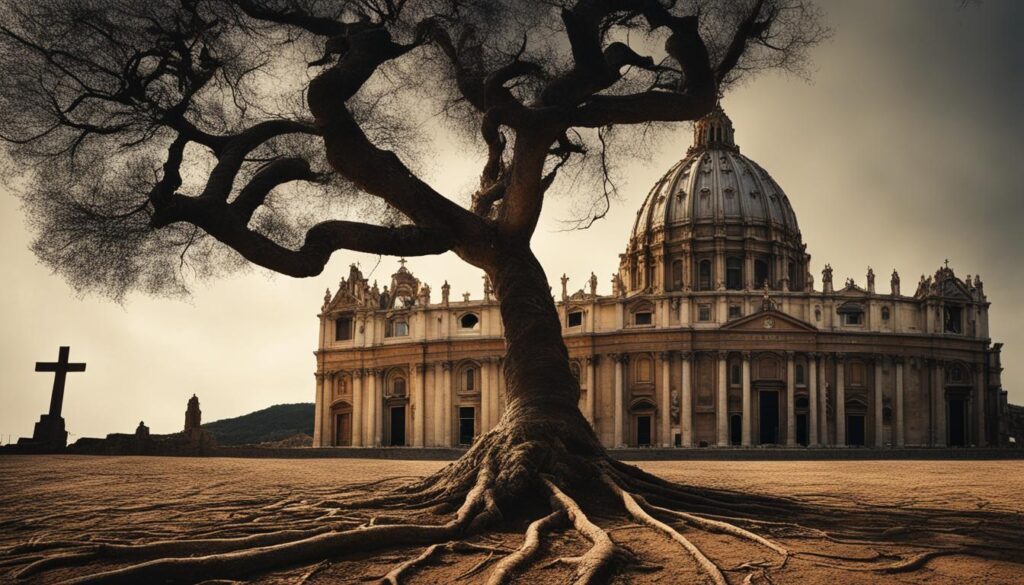
Resistance to Change
The resistance to change extended beyond the liturgy and teachings to the ecclesiastical structures. The shift towards a more inclusive and participatory approach challenged the hierarchical nature of the Church. Some clergy and traditionalists felt threatened by the increasing involvement of the laity and the diminishing authority of the clergy. This resistance often manifested as a struggle for power and control within the Church.
“We cannot stay locked in the past. The Spirit is calling us to adapt and evolve, even when it is difficult. Change is never easy, especially when it challenges deeply ingrained traditions, but it is necessary for growth and relevance in the modern world.” – Cardinal Martínez, Vatican II theologian
Overall, the challenges of post-conciliar development following Vatican II were rooted in the tension between tradition and transformation. The breakdown of long-standing practices and the resistance to change tested the faith and unity of the Catholic Church, requiring thoughtful reflection and adaptation to navigate the evolving landscape.
Interpretation and Reconciliation of Vatican II: Understanding the Legacy
The Second Vatican Council, or Vatican II, marked a significant turning point in the history of the Catholic Church. The reforms introduced during this period have had a profound impact on Catholic theology and practices. However, the interpretation and reconciliation of Vatican II have been topics of ongoing debate and discussion within the Church.
The need for a hermeneutic of the conciliar statements emerged as theologians and scholars sought to understand and implement the teachings of Vatican II. This hermeneutic approach involves interpreting the documents in light of the Church’s tradition and continuity, while also considering the specific historical context in which the Council took place.
“The interpretation of Vatican II is not a matter of simply picking and choosing which aspects of the Council to accept or reject. It requires a careful study of the conciliar texts, an understanding of the Church’s tradition, and a willingness to engage in dialogue and discernment,” explains theologian Dr. Maria Sanchez.
Reconciliation is also a key aspect of the post-conciliar development. The differing interpretations of Vatican II have led to divisions within the Church, with some individuals and groups embracing the reforms wholeheartedly, while others have resisted or criticized certain aspects. The challenge lies in finding common ground and fostering unity amidst diversity.
Ultimately, the interpretation and reconciliation of Vatican II are crucial for the Church’s growth and relevance in the modern era. By engaging in dialogue, studying the conciliar texts, and seeking a deeper understanding of the Council’s teachings, theologians and scholars strive to bridge the gaps and promote a more comprehensive and unified understanding of Vatican II. Through this process, the Church can continue to evolve and adapt while remaining rooted in its rich tradition and teachings.
The Relevance of Vatican II Today
Despite the challenges and controversies, Vatican II remains highly relevant to the Catholic Church today. Its emphasis on dialogue, inclusion, and active participation of the laity continues to shape the Church’s engagement with the modern world.
The developments since Vatican II have influenced the evolution of Catholic theology, practices, and the Church’s relationships with other Christian denominations and religions. The Council’s teachings on ecumenism have paved the way for greater dialogue and cooperation among different faith traditions, fostering a spirit of unity and understanding.
The ongoing impact of Vatican II can be seen in the transformation of liturgical practices, with Mass celebrated in the vernacular language and the incorporation of more lay participation. These changes have contributed to a more inclusive and engaging worship experience for Catholics worldwide.
Furthermore, Vatican II’s teachings on social justice and the dignity of every human person have inspired the Church’s commitment to addressing pressing global issues such as poverty, human rights, and environmental stewardship. The Council’s documents, such as Gaudium et Spes, provide a moral framework for the Church’s engagement in the world, guiding its advocacy and outreach efforts.
| Key Teachings and Impacts of Vatican II |
|---|
| “The Constitution on the Liturgy emphasized the importance of active participation of the faithful in worship, leading to the use of vernacular languages in Mass.” |
| “The Declaration on Religious Liberty affirmed the right to freedom of religion, promoting greater tolerance and understanding among different faith traditions.” |
| “The Dogmatic Constitution on Divine Revelation emphasized the importance of Scripture in shaping Catholic beliefs, encouraging Catholics to engage with the Word of God.” |
| “The Decree on Ecumenism fostered relationships with other Christian denominations, promoting dialogue and the pursuit of Christian unity.” |
| “The Declaration on the Relationship of the Church to Non-Christian Religions encouraged interreligious dialogue and respect for other religious traditions.” |
The ongoing interpretation and implementation of Vatican II are crucial for the Church’s growth and relevance in the modern era. Catholic theologians and scholars continue to explore the theological, pastoral, and social implications of the Council’s teachings, seeking to deepen understanding and promote greater unity within the Church.
Vatican II marked a transformative period in Catholic history, propelling the Church towards a more dynamic and inclusive future. Its impact can be felt in the lives of Catholics around the world, as they strive to live out the Council’s vision of a Church that is engaged with the world, rooted in tradition, and open to ongoing renewal.

Conclusion
The Second Vatican Council brought about significant developments and reforms that continue to shape the Catholic Church to this day. From liturgical changes to shifts in teachings and ecclesiastical structures, Vatican II propelled the Church into a more dynamic and inclusive future.
With its emphasis on the active participation of the laity, the Council’s impact on liturgical practices has allowed for a more engaging and meaningful worship experience for Catholics worldwide. The Constitution on the Liturgy, in particular, encouraged the use of vernacular languages, making the Mass more accessible and relatable to the faithful.
Moreover, Vatican II’s changes in Catholic teachings and doctrine marked a shift towards inclusivity and openness. The recognition of the laity’s role in the Church and the affirmation of religious liberty showcased the Council’s desire to engage with the modern world and promote dialogue and understanding.
Although the implementation and interpretation of Vatican II have posed challenges, the Council’s relevance remains undeniable. Its ongoing impact can be seen in the evolution of Catholic theology, practices, and the Church’s relationships with other Christian denominations and religions. As the Church continues to navigate the complexities of the modern era, the teachings and reforms of Vatican II serve as a guide for a more vibrant and engaged Catholicism.
FAQ
What is the Second Vatican Council?
The Second Vatican Council, also known as Vatican II, was a significant event in the Catholic Church that took place from 1962 to 1965. It resulted in numerous developments and reforms that continue to shape the Church today.
What were the key areas impacted by Vatican II?
Vatican II brought about changes in liturgy, teachings and doctrine, ecclesiastical structures, and Catholic Church practices.
What were the liturgical reforms introduced by Vatican II?
Vatican II introduced changes such as celebrating Mass in the vernacular language instead of Latin and emphasizing the active participation of the laity in worship.
How did Vatican II impact Catholic teachings and doctrine?
Vatican II emphasized the role of the laity in the Church, recognized the importance of ecumenism, and affirmed the right to freedom of religion.
What ecclesiastical changes occurred after Vatican II?
Vatican II fostered relationships with other Christian denominations, acknowledged the diversity within the Catholic Church, and affirmed the rights of Eastern Catholic communities.
How did Vatican II modernize Catholic Church practices?
Vatican II promoted interreligious dialogue and understanding, emphasized the importance of Scripture, and encouraged a more inclusive and dynamic approach to the modern world.
What challenges arose from the developments since Vatican II?
Some traditional practices and beliefs were criticized or lost, leading to tension and resistance within the Church. The changes created a period of uncertainty and adjustment for many Catholics.
Why is interpretation and reconciliation important for Vatican II?
The reception and interpretation of Vatican II have been subjects of ongoing debate and discussion. The hermeneutic of the conciliar statements guides the understanding and implementation of the Council’s teachings.
What is the relevance of Vatican II today?
Vatican II’s emphasis on dialogue, inclusion, and active participation of the laity continues to shape the Church’s engagement with the modern world and its relationships with other denominations and religions.


